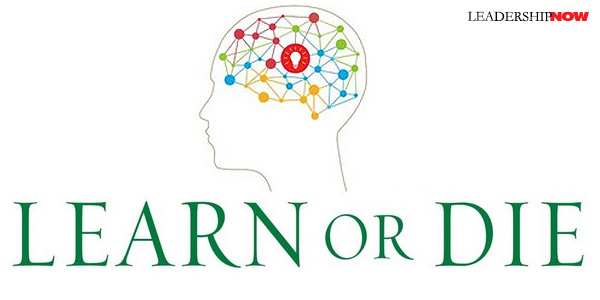 |
 |
11.26.14

Learn or Die
OUR ABILITY (and willingness) to learn impacts our personal and business growth, operational excellence, and our capacity to innovate. More than ever, it truly is learn or die. In Learn or Die, Ed Hess writes that learning is impacted by our “reflexive ways of thinking, the rigidity of our mental models, and the strength of our ego defense systems.” So to a large degree is means overcoming our humanness. We prefer to validate what we already know rather than looking at evidence to the contrary. By and large, that’s a function of our ego. “In many cases, learning comes from mistakes or failures or other people disagreeing with us, which that means in order to learn, we often have to admit that we are wrong.” The author admits that “To become a better learner, I had to quiet my ego.” As a result, he also became a better thinker and leader. Negative thinking is toxic to learning. “In order to maximize our learning we have to be sensitive to and manage our emotions.” As a leader, you need to be concerned about the environment of the people you lead. “The litmus test of a learning organization is being receptive to information that goes against the established way and a tolerance for failure and mistakes.” To accomplish this not only should the environment be positive, but people need to be treated with respect, dignity, and trust, mistakes should not be characterized as “personal failures but as the result of bad learning systems or too little effort,” people should also believe that they have some control over their actions, have a sense of self-efficacy and contribution. Hess writes that “The U.S. Army Special Forces believes that adaptability—learning—is predicated on self-efficacy, resiliency, open-mindedness, mastery achievement motivation, and tolerance for ambiguity and uncertainty.” Too often we sabotage our own learning by our need to be right. We need to be able to admit when we are wrong and quite frankly accept the “magnitude of our ignorance.” “Real learning, in most cases, requires us to change what we believe, and humble inquiry [open-mindedness with no predetermined or hidden agenda], helps us do that.” Because we have difficulty seeing ourselves and examining our own assumptions, “learning is a team sport.” If we want to learn, we “must engage in effective learning conversations.” Learning conversations are conversations where we feel safe in disclosing ourselves to others. They bring about a deliberate, nonjudgmental, non-defensive open-minded exchange. We learn from each other.
The culture at Bridgewater may seem extreme to some but there is no doubt that they are serious about growth and learning. As Ray sees it, achieving one’s goals is more likely to occur if one strives to be an independent thinker by learning. That, in turn, requires one to be honest about one’s strengths and weaknesses and to deal directly with one’s weaknesses by accepting them, seeking and being open to feedback and creating workarounds that mitigate one’s weaknesses. At Bridgewater, everyone knows everyone else’s strengths and weaknesses. It’s part of their company-wide feedback loop. It’s based on truth which Ray believes “is the essential foundation for producing good outcomes.” “Searching for the truth and confronting one’s personal weaknesses in a radically transparent environment builds personal relationships.” At Bridgewater they are just as concerned about how one arrives at an answer as they do the answer itself. They encourage people to be independent thinkers. A former Navy SEAL came to work at Bridgewater because he said the two cultures overlapped. “He said both organizations focus on learning, adaptation, recruiting high caliber people, and teaching them to be better thinkers and to relentlessly pursue constant improvement.” Bridgewater has created a series of tools for use in evaluating employees and for employees to manage their personal growth” the Dot Collector and Dot Connector, Issues Log and Issue Log Diagnosis Card, Pain Button and Baseball Card. With the Dot Collector allows anyone to give any other employee performance feedback. The Dot Connector is a database of feedback every employee has received from anyone. The data is grouped according to a list of seventy-seven attributes and then summarized to give each employee a picture of his or her feedback by strengths and weaknesses and by attributes. The Pain Button app is based on Ray’s formula: Pain + Reflection = Progress. “The purpose of the pain app is for one to write down and reflect on the ‘pains’ one is experiencing in order to understand what’s causing them and to deal with those causes effectively.” Ray himself is included in the process and is subject to evaluation by anyone in the company. Frankly, I have never read about an organization with such radical transparency. Hess says that in all of his research of over 100 high-performance companies over the past ten years, Bridgewater is the only business organization he has found that “has squarely faced our ‘humanness.’” Learn or Die is a book everyone who is serious about learning and growth—personally or organizationally—should read. If you thought you were serious about it, Learn or Die will take you to a whole new level with tools, case studies, and insights that will challenge your commitment to learning.

Posted by Michael McKinney at 11:28 AM
|
BUILD YOUR KNOWLEDGE
 

How to Do Your Start-Up Right STRAIGHT TALK FOR START-UPS 
Grow Your Leadership Skills NEW AND UPCOMING LEADERSHIP BOOKS 
Leadership Minute BITE-SIZE CONCEPTS YOU CAN CHEW ON 
Classic Leadership Books BOOKS TO READ BEFORE YOU LEAD |